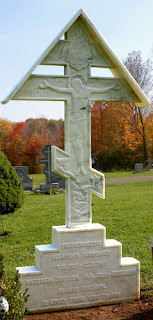
Dear Parish Faithful,
Christ is Risen!
I don't know how much of Pascha still remains in anyone, but today is the "official" Leavetaking of the Feast. Where did those forty days go? That means that tomorrow is the Feast of the Ascension of the Lord. This is probably the most "lost" of the great feasts, in that Ascension is always forty days after Pascha, and so always on a Thursday. Great Vespers on Wednesday of the eve and the Liturgy on Thursday, would thus draw a smattering of the faithful. That may be more or less unavoidable, but the unfortunate effect is to minimize our awareness of the glorious, awesome and essential celebration that the Ascension is. Pascha does not just disappear or vanish into thin air by some arbitrary decision. We don't just stop singing "Christ is Risen!" because we have had enough. Pascha culminates, or is "crowned," with the Ascension. And the Scriptures reveals to us that that was forty days after the Resurrection. Christ was raised from the dead in order to ascend into Heaven. This feast fulfills the paschal mystery. The Son of God "returns" to the Father, now glorified on His "right hand." When we "miss" the Feast, we "miss" a great Truth that reveals the full mystery of Christ - incarnate, raised, ascended and glorified.
Trying to respond to this situation pastorally, as announced we will celebrate the Feast of the Ascension of the Lord with a Vesperal Liturgy this evening beginning at 6:00 p.m. I am hoping that this will make it possible for many more of you to participate in the Feast and thus be more aware of this highly significant liturgical cycle of the forty days between our Lord's Resurrection and Ascension (ACTS 1:1-11) Being present in church for the service makes the reality of the Feast more of something experienced than simply an ecclesial event noted on the calendar. Preparing for, and then receiving the Eucharist, is the profoundest way that we celebrate a Feast, so again I hope that we can ascend in spirit as we gather together for this glorious Feast of the Ascension.
Trying to respond to this situation pastorally, as announced we will celebrate the Feast of the Ascension of the Lord with a Vesperal Liturgy this evening beginning at 6:00 p.m. I am hoping that this will make it possible for many more of you to participate in the Feast and thus be more aware of this highly significant liturgical cycle of the forty days between our Lord's Resurrection and Ascension (ACTS 1:1-11) Being present in church for the service makes the reality of the Feast more of something experienced than simply an ecclesial event noted on the calendar. Preparing for, and then receiving the Eucharist, is the profoundest way that we celebrate a Feast, so again I hope that we can ascend in spirit as we gather together for this glorious Feast of the Ascension.
Christ dies, descends to hell (hades), arises, and goes back up toward the heavenly Father. Between hell (hades) and heaven, between death and the resurrection, lies an uninterrupted line, an irresistible movement from the lowest to the highest point.... The lowest point of the descent into hell (hades), the lowering of Christ into the infernal regions, where God is not, coincides with the point of departure for heaven. In the kenosis (self-emptying), in which Christ abases himself, to the point of glory, there is a single, uninterrupted line, a single movement. By ascending, Jesus pulls all of us up with him, toward his Father who is also now our Father. (From The Incarnate God, Vol. II, p. 194-195).
Fr. Steven










